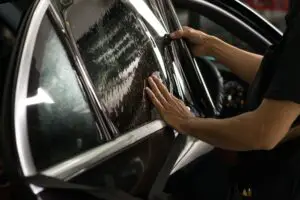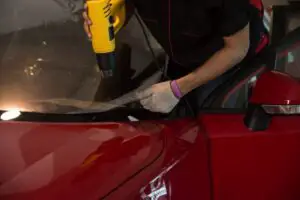Tinting laws in Wisconsin were implemented back in 1996 and set various rules and regulations that affected how dark, or reflective your window tints could be.
These laws have been kept updated since.
Currently, Wisconsin window tint laws have a lot of variation in VLT requirements, where some windows go as high as 50% while others can go as low as 35%.
This isn’t even talking about the reflection requirements and other laws.
If you want to fully understand how the law operates in the state of Wisconsin, make sure to read this article in its entirety, as I will go over all the rules set by the state and answer any questions you may have regarding window tints.
Table of Contents
- 1 How Much Tint Darkness Is Legal In Wisconsin?
- 2 Window Tint Reflection And Tint Colors
- 3 Medical Exemption Of Window Tint Laws In Wisconsin
- 4 Get A Certified Sticker From The Company
- 5 Other Window Tint Law Rules And Regulations In Wisconsin
- 6 Cost Of Car Window Tint In Wisconsin
- 7 Frequently Asked Questions
- 8 Conclusion
How Much Tint Darkness Is Legal In Wisconsin?

If you want to be safe, you should have more than 50% of the outside light able to get into the car.
If you know what you are doing, you can apply the correct VLT requirements and have 35% tints on select windows.
Tint Darkness Limit For SUVs And Vans
The rules are quite simple as long as you can remember the VLT requirements of each window.
Starting with the windshield, you should ensure that any tits you apply to it are above the AS 1 line that the manufacturer has set.
Furthermore, you are not allowed to have reflective tints on the windshield. You should know that these windows have the biggest VLT requirement of 50% for the front windows.
The back windows also have VLT requirements but are not as big as their requirements are lowered by about 15%.
This is true for the rear window as well. This means that you can have tints that are 35% dark on the rear window and the back seat side windows.
Tint Darkness Limit For Sedans
Sedans have more or less the same rules for window tinting. Here I will explain them on a per-window basis.
1. Front Windshield
Unfortunately for the windshield, the restrictions are more complex as reflective tints are not allowed. You must ensure that any tint you apply is according to the rules.
2. Front Seat Side Windows
Starting with these, you should ensure that any tints you apply have at least 50% VLT. This can be confusing as the rest of the windows have much lower requirements.
3. Rear Window
Talking about the lower requirements, I mentioned earlier. The rear window only has a 35% VLT requirement which you have to follow.
4. Back Seat Side Windows
This is true for the back windows, which must allow 35% of outside light to enter the vehicle.
Window Tint Reflection And Tint Colors
- A few laws have also been set in place by Wisconsin, limiting the amount of reflection your tints should be able to do and the colors you can apply to the tints.
- The front windows of all cars cannot have reflective tints.
- The back windows also cannot have reflective tint films.
- Wisconsin does not limit what colors you can and cannot apply to your car windows. This means that you can apply whatever colors you want.
Medical Exemption Of Window Tint Laws In Wisconsin

While rules are rules and everyone should follow them, there are certain cases where people must be exempt from the rules to preserve their health and condition.
This also applies to window tint laws, as well as many people in the United States who suffer from skin conditions or other illnesses that prevent them from being in the sun, causing them pain and discomfort.
For people like these, Wisconsin has allowed people to be medically exempt.
For this, the driver must have a written statement from a physician or doctor that states that they require special protection from the sun’s rays.
This statement must also include vital information such as the make and model of the car.
Get A Certified Sticker From The Company
Many states are split on whether they should or should not have their citizens apply certification stickers on their windows if they get them tinted.
On the one hand, this helps law enforcement certify that the tints are legal, while on the other hand, it can cause a lot of difficulties for the people.
The state of Wisconsin has opted not to require any form of certification from the people. This includes certification stickers as well as other legal documents.
This does not include medical exemption certificates or statements, which must be present with you at all times if you have applied for a medical exemption.
This also applies to the tint manufacturers who are not required to certify that the films they are producing fall under the standards set by the state of Wisconsin.
This offers a lot of convenience to the people.
Other Window Tint Law Rules And Regulations In Wisconsin
Here are a few more window tint laws that you should vary from when tinting your windows in Wisconsin.
- If you have your rear window tinted, you are legally obligated to use dual side mirrors.
- The state offers a 3% tint variance for its people, saving them from fines or punishment if they are slightly below the tint requirements.
- You are not required to carry any form of legal certifications related to your window tints.
- Medical exemptions are allowed, and you must carry the exemption statement with you.
- You are allowed to use all colors on your windows as tints.
Cost Of Car Window Tint In Wisconsin
There is a lot to consider when getting your windows tinted, but it falls to the price. Basic window tints can go for around $150.
These are very simple and low-quality tints that anyone should be able to afford.
If you want more quality, you should probably consider ceramic window tints, but these will cost you anything upwards of $400.
Various other factors affect the cost other than the quality and must be weighed when dealing with tinting costs.
Frequently Asked Questions
Q1. Is 15% Tint Legal In Wisconsin?
15% tints are completely illegal in the state of Wisconsin. Unless you are medically exempt, the law states that you cannot go below more than 35% VLT, making 15% tints illegal.
Q2. Are 5% Tints Legal In Wisconsin?
Since I have established that 15% of tints are not legal, it is fair to say that 5% of tints suffer the same fate and are not legal in Wisconsin.
You should try to avoid them as well as you can and stick to 50% tints for further safety.
Q3. Is Limo Tint Legal In Wisconsin?
Limo tints can get very dark and, for the most part, are below 15% tints which is why you should avoid them, as they will most likely be illegal in this state.
Q4. Can I Get Pulled Over For Tint In Wisconsin?
You should try your best to follow the rules set by the state and mentioned in this article, as the police will be out looking for people violating these rules and will pull you over if they believe you are breaking the law when it comes to tinting your windows.
Q5. How Much Is A Tint Ticket In Wisconsin?
With so many relaxations given to the people, it only makes sense that you should be punished for breaking the rules, which is why Wisconsin has set a fine of $175 and 50 cents for violating the rules.
This is the standard fine for violating the tint laws.
Conclusion
Wisconsin tint laws are very easy to understand if you put the time and effort into seeing how the tint’s VLT requirements work and all the laws which go into tinting your car windows.
The state has tried its best to provide relaxation to its citizens in tint variance, medical exemptions, and fewer restrictions when it comes to window tinting.
All of this should make following the window tinting laws much easier, and now that you have finished reading this article, it should be easy for you to follow these rules and regulations and be a model citizen.

I am Tahir Azam, and I have been writing amazing articles for TaxiHack for as long as I can remember. I know everything that is to know when it comes to automobiles and is always on top of industry news and developments. While I am not an expert by any means, I pride myself on knowing the ins and outs of many different problems and, of course, their solutions. The articles on our website are some of the best and well-researched content that you will find, and I spend countless hours making sure this remains to be true. This is why I ask you to take your time out and read some of my articles, especially if you find a topic that resonates with you or is something you are looking into. This way, you will find the perfect mix of information and tips on your desired topic. Learn more about Tahir.



